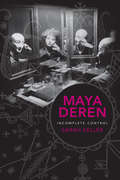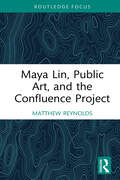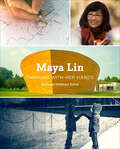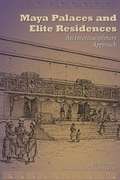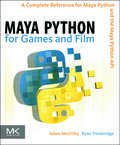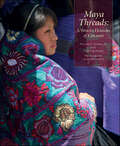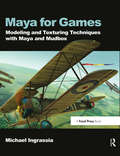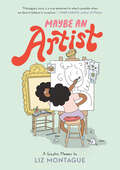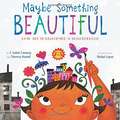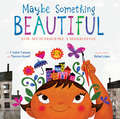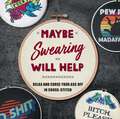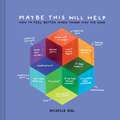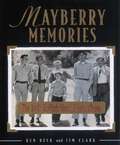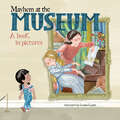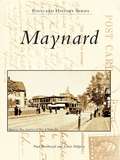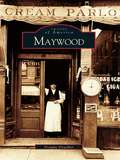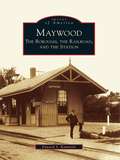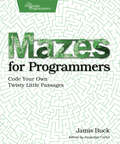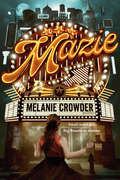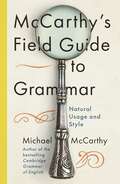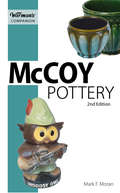- Table View
- List View
Maya Deren: Incomplete Control (Film and Culture Series)
by Sarah KellerMaya Deren (1917–1961) was a Russian-born American filmmaker, theorist, poet, and photographer working at the forefront of the American avant-garde in the 1940s and 1950s. Influenced by Jean Cocteau and Marcel Duchamp, she is best known for her seminal film Meshes of the Afternoon (1943), a dream-like experiment with time and symbol, looped narrative and provocative imagery, setting the stage for the twentieth-century's groundbreaking aesthetic movements and films.Maya Deren assesses both the filmmaker's completed work and her numerous unfinished projects, arguing Deren's overarching aesthetic is founded on principles of incompletion, contingency, and openness. Combining the contrasting approaches of documentary, experimental, and creative film, Deren created a wholly original experience for film audiences that disrupted the subjectivity of cinema, its standards of continuity, and its dubious facility with promoting categories of realism. This critical retrospective reflects on the development of Deren's career and the productive tensions she initiated that continue to energize film.
Maya Lin, Public Art, and the Confluence Project (Routledge Focus on Art History and Visual Studies)
by Matthew ReynoldsThe first scholarly monograph devoted exclusively to this vital work of contemporary public art, this book examines Maya Lin’s Confluence Project through the lens of environmental humanities and Indigenous studies. Matthew Reynolds provides a detailed analysis of each earthwork, along with a discussion of the proposed final project at Celilo Falls near The Dalles, Oregon. The book assesses the artist’s longtime engagement with the region of the Pacific Northwest and explores the Confluence Project within Lin’s larger oeuvre. Several consistent themes and experiences are common amongst all the sites. These include an emphasis on individual, multisensory encounters with the earthworks and their surrounding contexts; sound as an experiential dimension of landscape; indexical accounts of the multicultural, multispecies histories of each place; and an evocation of loss. The book will be of interest to scholars working in art history, contemporary art, environmental studies, environmental humanities, and Native American studies.
Maya Lin: Artist-Architect of Light and Lines
by Jeanne Walker HarveyThe bold story of Maya Lin, the visionary artist-architect who designed the Vietnam Veterans Memorial.You may be familiar with the iconic Vietnam Veterans Memorial. But do you know about the artist-architect who created this landmark?As a child, Maya Lin loved to study the spaces around her. She explored the forest in her backyard, observing woodland creatures, and used her house as a model to build tiny towns out of paper and scraps. The daughter of a clay artist and a poet, Maya grew up with art and learned to think with her hands as well as her mind. From her first experiments with light and lines to the height of her success nationwide, this is the story of an inspiring American artist: the visionary artist-architect who designed the Vietnam Veterans Memorial.A Christy Ottaviano Book
Maya Lin: Thinking with Her Hands
by Susan Goldman RubinThe Vietnam Veterans Memorial in Washington, D.C., is one of the most famous pieces of civic architecture in the world. But most people are not as familiar with the reserved college student who entered and won the design competition to build it. This accessible biography tells the story of Maya Lin, from her struggle to stick with her vision of the memorial to the wide variety of works she has created since then. The carefully researched text, paired with ample photos, crosses multiple interests—American history, civic activism, art history, and cultural diversity—and offers a timely celebration of the memorial's 35th anniversary as well as providing an important contribution to the current discussion of the role of women and minorities in society.
Maya Palaces and Elite Residences: An Interdisciplinary Approach
by Jessica Joyce ChristieMaya "palaces" have intrigued students of this ancient Mesoamerican culture since the early twentieth century, when scholars first applied the term "palace" to multi-room, gallery-like buildings set on low platforms in the centers of Maya cities. Who lived in these palaces? What types of ceremonial and residential activities took place there? How do the physical forms and spatial arrangement of the buildings embody Maya concepts of social organization and cosmology? This book brings together state-of-the-art data and analysis regarding the occupants, ritual and residential uses, and social and cosmological meanings of Maya palaces and elite residences. A multidisciplinary team of senior researchers reports on sites in Belize (Blue Creek), Western Honduras (Copan), the Peten (Tikal, Dos Pilas, Aguateca), and the Yucatan (Uxmal, Chichen-Itza, Dzibilchaltun, Yaxuna). Archaeologist contributors discuss the form of palace buildings and associated artifacts, their location within the city, and how some palaces related to landscape features. Their approach is complemented by art historical analyses of architectural sculpture, epigraphy, and ethnography. Jessica Joyce Christie concludes the volume by identifying patterns and commonalties that apply not only to the cited examples, but also to Maya architecture in general.
Maya Programming with Python Cookbook
by Adrian HerbezMaster complex workflows and conquer the world with Python and Maya About This Book * Improve your modelling skills and reduce your scripting problems using Python in Maya * Learn to communicate with web applications using Python for easier team development * A quick and practical answer to every problem you can have whilst scripting in Maya with Python Who This Book Is For This book is for Python developers who have just started scripting with Maya. What You Will Learn * Find out how to use Python scripting to automate tedious tasks * Create functional user interfaces to make scripts easy to share with others * Add new functionality to Maya via the power of scripting * Import and export arbitrary data into and out of Maya * Improve your workflow, and that of your team * Create custom create custom controls to make rigs that are easy to work with * Implement a system to render 3D assets for isometric games * Use script jobs to trigger actions automatically in response to user interaction * Open a command port to allow other applications to communicate with Maya In Detail Maya is a 3D graphics and animation software, used to develop interactive 3D applications and games with stupendous visual effects. The Maya Programming with Python Cookbook is all about creating fast, powerful automation systems with minimum coding using Maya Python. With the help of insightful and essential recipes, this book will help you improve your modelling skills. Expand your development options and overcome scripting problems encountered whilst developing code in Maya. Right from the beginning, get solutions to complex development concerns faced when implementing as parts of build. Style and approach This book is comprised of a set of practical recipes, grouped under specific topics, which can be referred to independently or in sequence. These recipes provide quick solutions to common problems, and cover most of the real-world scenarios that developers are likely to face when working with Maya.
Maya Python for Games and Film: A Complete Reference for the Maya Python API
by Adam Mechtley Ryan TrowbridgeThis book is among the first books to provide an in-depth look at how to implement Python with Maya,. It is an ideal resource for technical artists looking to boost productivity and enhance performance and interoperability. With this practical guide written by trusted authorities in the field, experienced technical artists will make the transition from the older MEL scripting language to Python and aspiring artists will save themselves time right from the beginning.
Maya Threads: A Woven History of Chiapas
by Carol Karasik Walter F. MorrisWinner of: IBPA 2016 Benjamin Franklin Gold Award, Multicultural Through the pages of this incredibly-researched history and photo gallery, the world of the Maya lives on through the lens of its culture and costume, still seen today in the state of Chiapas in southern Mexico. In a region battered by centuries of invasions, subjugations, civil wars, and severe economic hardship, the Maya continue to celebrate and sustain their heritage in extraordinary traditional dress and festivals that are both riotous and sacred. Their ever-evolving, colorful, beautifully-handcrafted dress features exquisite gauze fabrics that trace their origins from the 9th century AD to a present-day lowland village; festival wear that blends Roman Catholicism and paganism, reverence and mockery; gloriously brocaded and embroidered wardrobes that tie communities together; and embroidery techniques that reflect displacements and migrations—in other words, fabrics that trace the history and evolution of a people. Two Maya experts and a photographer painstakingly record the remnants of influence from the Aztecs, Spanish conquistadors, Catholic missionaries, and the unseen gods and spirits that guide Maya culture today.
Maya for Games: Modeling and Texturing Techniques with Maya and Mudbox
by Michael IngrassiaWell-known Maya professional, Michael Ingrassia, takes readers through his unique style of modeling: "Image Based Modeling" where efficient, realistic models can be created very quickly. Ingrassia's techniques allow modelers to create exact replicas of their concept characters or objects. The techniques presented are very efficient and allow game modelers to quickly build out stand alone props to populate environments and game levels. Presented are tried and true techniques that the author has used successfully in game production for the past 10 years. Most, if not all 3D books, focus on basic "box" modeling techniques, which are the basis for proper 3D modeling but not the complete solution. In the author's experience, students who have learned through the Image Based Modeling brand, have quickly excelled into effective modelers. One of the hardest things for any modeler to do is match their model EXACTLY to the concept art or photos they are provided. The insider tips in this book walk artists through this process. Artists begin with basic modeling and advance to a creating a complete scene and set design/game level. Rather than including sporadic models with zero association from to one another, each model in the book becomes an integral part of an overall theme realistic in game development today. The accompanying downloadable resources include 8 exclusive video tutorials on advanced Maya techniques as bonus tracks for artists providing invaluable modeling, rigging and texturing samples. Also, an in-depth video on assembling a "Killer Demo Reel" showing simple but effective video editing techniques used by the author so that artists can learn how to get their work seen. The book not only teaches effective methodology, but provides the user with impressive content for producing effective demo reels and portfolios. Pros and cons of demo reel, website and artist representation are given, along with insights into the expectations of game studios today. The video tutorials show users the finished product, and then run through the process of step by step creation of that particular technique.
Maybe An Artist, A Graphic Memoir
by Liz MontagueA heartfelt and funny graphic novel memoir from one of the first Black female cartoonists to be published in the New Yorker, when she was just 22 years old.When Liz Montague was a senior in college, she wrote to the New Yorker, asking them why they didn't publish more inclusive comics. The New Yorker wrote back asking if she could recommend any. She responded: yes, me. Those initial cartoons in the New Yorker led to this memoir of Liz's youth, from the age of five through college--how she navigated life in her predominantly white New Jersey town, overcame severe dyslexia through art, and found the confidence to pursue her passion. Funny and poignant, Liz captures the age-old adolescent questions of &“who am I?&” and &“what do I want to be?&” with pitch-perfect clarity and insight. This brilliant, laugh-out-loud graphic memoir offers a fresh perspective on life and social issues and proves that you don&’t need to be a dead white man to find success in art.
Maybe Something Beautiful: How Art Transformed A Neighborhood (Into Reading, Read Aloud Module 2 #2)
by Rafael López Theresa Howell F. CampoyNIMAC-sourced textbook <P><P>What good can a splash of color do in a community of gray? As Mira and her neighbors discover, more than you might ever imagine! Based on the true story of the Urban Art Trail in San Diego, California, Maybe Something Beautiful reveals how art can inspire transformation—and how even the smallest artists can accomplish something big. Pick up a paintbrush and join the celebration! <P><P>Lexile Measure: AD580L
Maybe Something Beautiful: How Art Transformed a Neighborhood
by F. Isabel Campoy Rafael López Theresa HowellWhat good can a splash of color do in a community of gray? As Mira and her neighbors discover, more than you might ever imagine! Based on the true story of the Urban Art Trail in San Diego, California, Maybe Something Beautiful reveals how art can inspire transformation—and how even the smallest artists can accomplish something big. Pick up a paintbrush and join the celebration!
Maybe Swearing Will Help: Relax and Curse Your Ass Off in Cross-Stitch
by Weldon OwenThere are times when just hollering obscenities won&’t do—you need to stab something. Now you can do both. Maybe Swearing Will Help combines two of the best stress-relievers—cursing, and cross stitch—into one of the most irreverently enjoyable crafting experiences you&’ll ever have. With 25 patterns from the crafting world&’s most bad-ass cross-stitch designers, this book has everything from a modern take on the traditional sampler to retro comic book designs, all with snarky to downright foul-mouthed phrases. It is definitely not your grandmother&’s cross stitch! No previous experience is required. In addition to simple instructions and clear, easy-to-follow patterns, the book includes a guide to basic lesson in cross-stitch techniques, so anyone can start swearin&’ and stabbin&’ right away. Whether you want the world to know that they need to wash their damn hands or you want to stitch a gift for your favorite potty mouth, Maybe Swearing Will Help has just what you need to find your way to inner f*cking peace. SWEARING AND STABBING: Get out your aggressions with a easy-to-make foul-mouth cross-stitch projects 25 PATTERNS: Choose from dozens of designs to send just the right message, from Bollocks to F*ck It FOR EVERY SKILL LEVEL: From beginning potty-mouths to expletive experts, Maybe Swearing Will Help includes complete patterns, step–by-step instructions, and a guide to cross-stitch basics TOP DESIGNERS: Patterns created by more than a dozen of the f*cking best-selling cross-stitch designers and influencers on Etsy INSPIRING IMAGES: Full-color images of the finished projects help ensure success and offer ideas of how to frame and display your beautiful damned artwork.
Maybe This Will Help: How to Feel Better When Things Stay the Same
by Michelle RialA visual pep talk of charts and essays on feeling better about not feeling better.Maybe This Will Help is one part the funny and relatable graphs that fans of Am I Overthinking This? and of Michelle Rial know and love, and one part the honest stories behind what makes those graphs so poignant. Michelle Rial brings to light her struggles with chronic pain, grief, and creative uncertainty in a way that reflects the universality of dealing with the unthinkable. Equal parts funny and moving, this book delves into the more serious side of things, finding levity and collective experience in the invisible difficulties that so many of us face. Through humorous charts and intimate peeks into the author's life, it explores the big things that can feel unmanageable and the everyday humor that keeps us moving forward.SELF-HELP WITH HUMOR: This book brings levity and laughter to serious topics without undermining the important message and relatability that makes it resonate.BELOVED AUTHOR: Michelle Rial's first book was beloved by her tens of thousands of fans as well as by the media, including Wired, Vulture, Book Riot—and the New Yorker even published her chart-based article on "Book Publishing by the Numbers."JUST THE RIGHT TONE: This book perfectly captures trying to figure out the "magic pill" that will fix things, struggling to find peace in how things are, and the humor in even the hardest times. It makes an ideal gift for someone struggling with physical or mental pain when you want to help but aren't sure how to.Perfect for: Fans of Michelle Rial's Instagram and first book, Am I Overthinking This?; people in their 20s and 30s grappling with big life changes or chronic illness
Maybe Your Leg Will Grow Back!: Looking on the Bright Side with Baby Animals
by Ben Schwartz Amanda McCallFinding the bright side of a terrible situation has never been easier, thanks to the adorable baby animal postcards found in Maybe Your Leg Will Grow Back. Amanda McCall and Ben Schwartz, nationally bestselling authors of Grandma’s Dead and Why is Daddy in a Dress?, are back with their third collection of cuteness designed to soften life’s unexpected blows, whether you’re dealing with shark attacks, incurable diseases, or incarcerations in filthy third world prisons. With delicious dark humor in vein of The Bunny Suicides, Maybe Your Leg Will Grow Back even includes a bonus DIY crafts section to help you find the sunny side of any catastrophe.
Mayberry Memories: The Andy Griffith Show Photo Album
by Jim ClarkMayberry Memories: The Andy Griffith Show Photo Album is the most beautiful coffee-table book ever to be released on one of the most beloved television shows in history. Celebrating the 40th anniversary of THE ANDY GRIFFITH SHOW, this book features nearly 300 beautifully reproduced photographs in both color and black and white, the majority of which have never before been published. MAYBERRY MEMORIES is the ultimate keepsake memento for fans who have enjoyed everything Mayberry for four decades.
Mayhem at the Museum: A Book in Pictures
by Luciano LozanoPaintings and sculptures come to life when a young girl visits the Metropolitan Museum of Art with her classmates. What starts as just another tour of the museum becomes a joyful parade as the art, which must not be touched, touches the young museum-goers in surprising ways.Images of works in New York's Metropolitan Museum of Art are beautifully illustrated as dynamic characters by Luciano Lozano Raya in this wordless picture book. Famous paintings and sculptures from throughout the museum will be recognizable to adults while the mischievous breaking of the fourth wall will delight younger readers.
Maynard
by Lewis Halprin Paul BoothroydMaynard was incorporated in 1871 as a manufacturing community. By 1880, it was one of the most influential towns in Massachusetts. As the population boomed from an expansion in business, postcards became the substantial method of communication. Local photographers took advantage of the events, pictorial venues, and influx of immigrants and visitors to create many unusual postcards of Maynard. Through vintage postcards, Maynard shows how this town, once a farming community, has retained its friendly, small-town character.
Maywood (Images of America)
by Douglas DeuchlerTen miles west of Chicago on the west bank of the Des Plaines River sits Maywood, a village that was founded in 1869 by seven New England businessmen who established the Maywood Land Company. This prairie community, carefully laid out along the railroad, experienced a population boom after the Great Chicago Fire of 1871. Soon industry arrived, followed by a variety of ethnic groups. Maywood was one of the few early suburban communities with an African-American neighborhood.
Maywood: The Borough, the Railroad, and the Station
by Edward S. KaminskiOriginally settled by Dutch farmers in the 1600s, the borough of Maywood experienced population and industrial growth in the late 1800s with the coming of the railroad. New Jersey Midland Railway, predecessor to the New York, Susquehanna and Western Railroad, arrived in 1872, a time when Maywood consisted mainly of farmland. Maywood was incorporated in 1894, when the railroad expanded into the Pennsylvania coalfields. The railroad provided the means for transportation of people, goods, and services, and Maywood grew measurably with it into the 20th century. Today the borough has developed into a suburb of such iconic cities as New York City, Paterson, Passaic, and Hackensack, while still retaining its character and charm.
Mazes for Programmers: Code Your Own Twisty Little Passages
by Jamis BuckUnlock the secrets to creating random mazes! Whether you're a game developer, an algorithm connoisseur, or simply in search of a new puzzle, you're about to level up. Learn algorithms to randomly generate mazes in a variety of shapes, sizes, and dimensions. Bend them into Moebius strips, fold them into cubes, and wrap them around spheres. Stretch them into other dimensions, squeeze them into arbitrary outlines, and tile them in a dizzying variety of ways. From twelve little algorithms, you'll discover a vast reservoir of ideas and inspiration.From video games to movies, mazes are ubiquitous. Explore a dozen algorithms for generating these puzzles randomly, from Binary Tree to Eller's, each copiously illustrated and accompanied by working implementations in Ruby. You'll learn their pros and cons, and how to choose the right one for the job.You'll start by learning six maze algorithms and transition from making mazes on paper to writing programs that generate and draw them. You'll be introduced to Dijkstra's algorithm and see how it can help solve, analyze, and visualize mazes. Part 2 shows you how to constrain your mazes to different shapes and outlines, such as text, circles, hex and triangle grids, and more. You'll learn techniques for culling dead-ends, and for making your passages weave over and under each other. Part 3 looks at six more algorithms, taking it all to the next level. You'll learn how to build your mazes in multiple dimensions, and even on curved surfaces.Through it all, you'll discover yourself brimming with ideas, the best medicine for programmer's block, burn-out, and the grayest of days. By the time you're done, you'll be energized and full of maze-related possibilities!What You Need:The example code requires version 2 of the Ruby programming language. Some examples depend on the ChunkyPNG library to generate PNG images, and one chapter uses POV-Ray version 3.7 to render 3D graphics.
Mazie
by Melanie Crowder*"Deserves a standing ovation." --Kirkus Reviews (starred review) *"The peppy first-person narrative keeps the story zipping along, and adroitly placed period details make the setting come alive in this bighearted, exuberant novel." --Publishers Weekly (starred review) An eighteen-year-old aspiring actress trades in starry Nebraska skies for the bright lights of 1950s Broadway in this show-stopping novel from award-winning author Melanie Crowder. Mazie has always longed to be on Broadway. But growing up in her small Nebraska town, that always seemed like an impossible dream. So when an opportunity presents itself to spend six weeks auditioning, Mazie jumps at the chance, leaving behind everything--and everyone--she's ever known.New York City is a shock to the senses: thrilling, but lonely. Auditions are brutal. Mazie's homesick and she misses the boyfriend whose heart she broke when she left. Nothing is as she expected.With money running out, and faced with too many rejections to count, Mazie is more determined than ever to land a role. But when she discovers that booking a job might mean losing sight of herself, everything Mazie always thought she wanted is called into question. Mazie is the story of a girl caught between two lives--and two loves--as she navigates who she is, what matters most, and the cost of following her dream. Praise for Mazie: "Entertaining and heartfelt."-- Booklist "Mazie&’s authenticity makes this novel stand out. Recommended for all collections, especially where theater is popular."– School Library Journal
McCarthy's Field Guide to Grammar: Natural English Usage and Style
by Michael McCarthyYou ain't gonna like it: bad grammar's not so bad. - The TimesRemember all those grammar rules from school? No? Most of us don't. Mike McCarthy, renowned corpus linguist and co-author of the 900-page Cambridge Grammar of English answers the awkward questions that regularly bother us about English grammar. In this helpful A-Z field guide, McCarthy tells us what the conventional rules are as well as shows us what people are writing or saying now and gives simple reasons why you might choose one or the other so that you can speak and write with confidence.Through witty and entertaining examples pulled from 50 years of teaching, 40 years of field notes picked from books, newspapers, letters, radio and TV, etc., and shamelessly eavesdropping on people's conversations in public spaces, and a British and American English computer database, McCarthy has created a book to browse and enjoy, as well as a useful reference to keep on your bookshelf.Why a Field Guide to grammar?- A to Z format makes it easy to access and to find what you're looking for- Presents solutions to a host of common, everyday grammatical problems- References current events to bring relevance to the grammar (fronted adverbials anyone?)- Looks at historical usage to illustrate how the English language has evolved, and continues to evolve- Gives guidance on appropriate usage where more than one way of saying something exists- Distinguishes between spoken and written grammar where appropriate- includes advice on vocabulary, spelling, pronunciation, punctuation and style- Compares North American and British grammar, and includes Englishes from around the world- Charming drawings to illustrate the playfulness in the English language- Grammar guide backed by data and researchTrue to the Chambers name, this field guide is as much quirky as it is informative. It is the perfect gift for any language lover, student, teacher, struggling parent or carer supporting their child's schooling, the grammar purist or the grammar descriptivist.
McCarthy's Field Guide to Grammar: Natural English Usage and Style
by Michael McCarthyYou ain't gonna like it: bad grammar's not so bad. - The TimesRemember all those grammar rules from school? No? Most of us don't. Mike McCarthy, renowned corpus linguist and co-author of the 900-page Cambridge Grammar of English answers the awkward questions that regularly bother us about English grammar. In this helpful A-Z field guide, McCarthy tells us what the conventional rules are as well as shows us what people are writing or saying now and gives simple reasons why you might choose one or the other so that you can speak and write with confidence.Through witty and entertaining examples pulled from 50 years of teaching, 40 years of field notes picked from books, newspapers, letters, radio and TV, etc., and shamelessly eavesdropping on people's conversations in public spaces, and a British and American English computer database, McCarthy has created a book to browse and enjoy, as well as a useful reference to keep on your bookshelf.Why a Field Guide to grammar?- A to Z format makes it easy to access and to find what you're looking for- Presents solutions to a host of common, everyday grammatical problems- References current events to bring relevance to the grammar (fronted adverbials anyone?)- Looks at historical usage to illustrate how the English language has evolved, and continues to evolve- Gives guidance on appropriate usage where more than one way of saying something exists- Distinguishes between spoken and written grammar where appropriate- includes advice on vocabulary, spelling, pronunciation, punctuation and style- Compares North American and British grammar, and includes Englishes from around the world- Charming drawings to illustrate the playfulness in the English language- Grammar guide backed by data and researchTrue to the Chambers name, this field guide is as much quirky as it is informative. It is the perfect gift for any language lover, student, teacher, struggling parent or carer supporting their child's schooling, the grammar purist or the grammar descriptivist.
McCoy Pottery, Warman's Companion (Warman's Companion)
by Mark F. MoranThis edition of McCoy contains essential identifying details and descriptions for everything from McCoy-made cookie jars and crocks to planters, vases and flower pots. The compact size provides access to facts and photos for inspection during auctions, shows, estate sales, flea markets, without being too cumbersome to tote. Inside the pages of this go-to-guide is an impressive collection of vibrant color photos, updated prices, makers marks, company history, and market trends.
